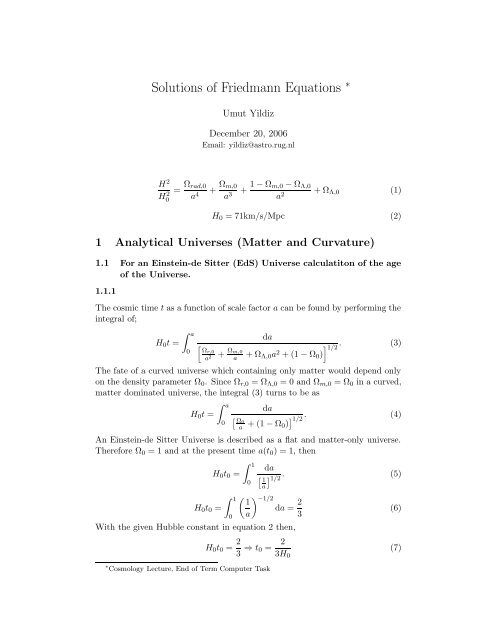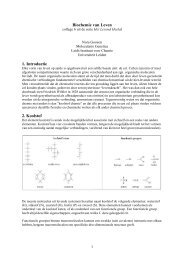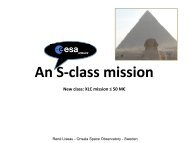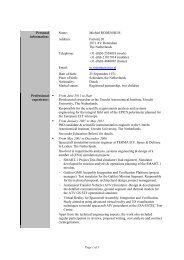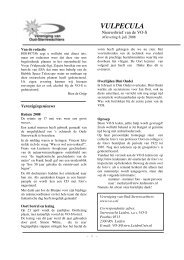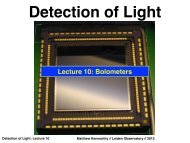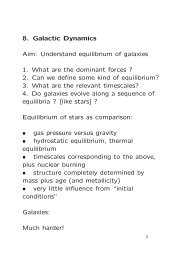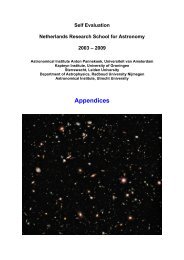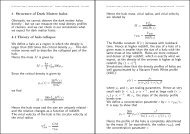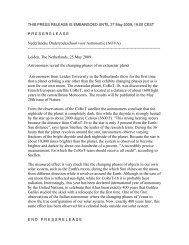Solutions of Friedmann Equations ∗
Solutions of Friedmann Equations ∗
Solutions of Friedmann Equations ∗
Create successful ePaper yourself
Turn your PDF publications into a flip-book with our unique Google optimized e-Paper software.
<strong>Solutions</strong> <strong>of</strong> <strong>Friedmann</strong> <strong>Equations</strong> <strong>∗</strong><br />
H 2<br />
H 2 0<br />
= Ωrad,0<br />
a 4<br />
Umut Yildiz<br />
December 20, 2006<br />
Email: yildiz@astro.rug.nl<br />
Ωm,0<br />
+<br />
a3 + 1 − Ωm,0 − ΩΛ,0<br />
a2 + ΩΛ,0<br />
(1)<br />
H0 = 71km/s/Mpc (2)<br />
1 Analytical Universes (Matter and Curvature)<br />
1.1 For an Einstein-de Sitter (EdS) Universe calculatiton <strong>of</strong> the age<br />
<strong>of</strong> the Universe.<br />
1.1.1<br />
The cosmic time t as a function <strong>of</strong> scale factor a can be found by performing the<br />
integral <strong>of</strong>;<br />
H0t =<br />
a<br />
0<br />
da<br />
Ωr,0<br />
a 2 + Ωm,0<br />
a + ΩΛ,0a 2 + (1 − Ω0)<br />
1/2 . (3)<br />
The fate <strong>of</strong> a curved universe which containing only matter would depend only<br />
on the density parameter Ω0. Since Ωr,0 = ΩΛ,0 = 0 and Ωm,0 = Ω0 in a curved,<br />
matter dominated universe, the integral (3) turns to be as<br />
H0t =<br />
a<br />
0<br />
da<br />
Ω0<br />
a + (1 − Ω0) . (4)<br />
1/2<br />
An Einstein-de Sitter Universe is described as a flat and matter-only universe.<br />
Therefore Ω0 = 1 and at the present time a(t0) = 1, then<br />
1<br />
H0t0 =<br />
0<br />
1<br />
H0t0 =<br />
0<br />
1<br />
a<br />
da<br />
. (5)<br />
1/2<br />
−1/2 1<br />
da =<br />
a<br />
2<br />
3<br />
With the given Hubble constant in equation 2 then,<br />
H0t0 = 2<br />
3 ⇒ t0 = 2<br />
3H0<br />
<strong>∗</strong> Cosmology Lecture, End <strong>of</strong> Term Computer Task<br />
(6)<br />
(7)
The Hubble constant is given at the value <strong>of</strong> [km/s/Mpc], then in order to get<br />
the time in terms <strong>of</strong> Gyr we need to make some conversions like<br />
1 Mpc = 3.085678 × 10 19 km<br />
1 year = 31536000 sec, then<br />
2 × 3.085678 × 10 19 km<br />
3 × 71km/s/Mpc × 31536000s<br />
The age <strong>of</strong> the EdS universe is 9.187 Gyr.<br />
1.1.2 Computer Calculations<br />
= 9.187Gyr (8)<br />
All the program pieces written for the next tasks calls the module (cosmomodule.py)<br />
given below. It consists <strong>of</strong> calling some Python modules, constants and<br />
etc...<br />
1.1.3 Python Code<br />
cosmomodule.py<br />
from Numeric import *<br />
from pylab import *<br />
from matplotlib.numerix import *<br />
## Constants<br />
H = 71.0 ## Hubble Constant = 71 km/s/Mpc<br />
Mpc = 3.085677581e+19 #kms<br />
km = 1.0<br />
Gyr= 3.1536e16 #seconds<br />
H0 = (H * Gyr * km / Mpc)<br />
## For LaTeX in the Plots<br />
rc(’text’, usetex=True)<br />
rc(’ps’, usedistiller="xpdf")<br />
## For Legends (Arrays)<br />
openlegend =<br />
[’$\Omega_{0}=1.0$’,’$\Omega_{0}=0.9$’,’$\Omega_{0}=0.8$’,<br />
’$\Omega_{0}=0.3$’,’$\Omega_{0}=0.1$’]<br />
closedlegend =<br />
[’$\Omega_{0}=1.1$’,’$\Omega_{0}=1.2$’,’$\Omega_{0}=1.5$’,<br />
’$\Omega_{0}=2.0$’]<br />
openclosedlegend =<br />
[’$\Omega_{0}=0.1$’,’$\Omega_{0}=0.3$’,’$\Omega_{0}=0.8$’,<br />
’$\Omega_{0}=0.9$’,’$\Omega_{0}=1.0$’,’$\Omega_{0}=1.1$’,<br />
’$\Omega_{0}=1.2$’,’$\Omega_{0}=1.5$’,’$\Omega_{0}=2.0$’]<br />
2
1.2 For EdS Universe plot <strong>of</strong> a(t) versus t<br />
1.2.1<br />
In Einstein-de Sitter Universe the scale factor as a function <strong>of</strong> time is found by<br />
<br />
t<br />
a(t) =<br />
t0<br />
2/3<br />
where a(t0) is the expansion factor at the present time which is represented by<br />
a circle in the plot.<br />
Figure 1: In EdS Universe, the plot <strong>of</strong> scale factor a(t) versus time (Gyr)<br />
1.2.2 Python Code<br />
#!/usr/bin/python<br />
#q2.py<br />
from cosmomodule import *<br />
t = arange(0.0,20.0,1)<br />
t0=9.187<br />
a_t = (t/t0)**(2.0/3.0)<br />
plot(t, a_t, ’r’)<br />
scatter(array([t0]), array([1.0]), 20, c=’b’, marker=’o’)<br />
text(9.0,(1.0)**(2.0/3.0)+0.1, "$t = t_{0}$")<br />
title(’${\small Einstein-de Sitter Universe}$’)<br />
xlabel(’t (Gyr)’)<br />
ylabel(’a(t)’)<br />
grid(True)<br />
legend([’$\Omega_{0}=1.0$’])<br />
show()<br />
3<br />
(9)
1.3 For Open Universes with Ω0 = 0.9, 0.8, 0.3, 0.1, present age <strong>of</strong><br />
these universes.<br />
1.3.1<br />
In a negatively curved Universe containing only matter (Ω0 < 1, κ = −1), the<br />
present age <strong>of</strong> the Universe is given by the formula (Ryden [2003], eq 6.44)<br />
<br />
1 Ω0<br />
2 − Ω0<br />
H0t0 = −<br />
cosh−1 . (10)<br />
1 − Ω0 2(1 − Ω0) 3/2 Ω0<br />
For the given values <strong>of</strong> universes with Ω0 = 0.9, 0.8, 0.3, 0.1, present age <strong>of</strong> these<br />
universes<br />
1.3.2 Python Code<br />
#!/usr/bin/python<br />
#q3.py<br />
from cosmomodule import *<br />
Ω0 t0(Gyr)<br />
0.9 9.3795<br />
0.8 9.5904<br />
0.3 11.1461<br />
0.1 12.3772<br />
def t0(oz): ## oz and omz refers to Omega_{0}<br />
eq=1./(1.-oz) - (oz/(2.*(1.-oz)**(3./2.))* arccosh((2.-oz)/oz))<br />
return eq<br />
omz = array([0.9,0.8,0.3,0.1])<br />
for j in omz:<br />
print t0(j) /(H*Gyr*km/Mpc)<br />
4
1.4 Plot <strong>of</strong> a(t) versus t for Ω0 = 0.9, 0.8, 0.3, 0.1 Open and Ω0 = 1.0<br />
EdS Universe.<br />
1.4.1 Answer<br />
The analytical solutions <strong>of</strong> the <strong>Friedmann</strong> equation for the Open universes is<br />
given in the parametric form in (Ryden [2003], eq 6.20, 6.21). In the equation<br />
the parameter η runs from 0 to infinity.<br />
a(η) = 1<br />
2<br />
Ω0<br />
(cosh η − 1) (11)<br />
1 − Ω0<br />
t(η) = 1 Ω0<br />
(sinh η − η) (12)<br />
2H0 (1 − Ω0) 3/2<br />
Figure 2: Plot <strong>of</strong> a(t) versus t for Ω0 = 0.9, 0.8, 0.3, 0.1 Open and Ω0 = 1.0 EdS<br />
Universe.<br />
5
1.4.2 Python Code<br />
#!/usr/bin/python<br />
#q4.py<br />
from cosmomodule import *<br />
def aeta(oz, eeta): ## oz and omz refers to Omega_{0}<br />
eq=(1.0/2.0)*(oz/(1.0-oz))*(cosh(eeta)-1.0)<br />
return eq<br />
def teta(oz, eeta):<br />
eq=(1.0/2.0)*(1.0/(H*Gyr*km/Mpc))*(oz/((1.0-oz)**(3.0/2.0)))*(sinh(eeta)-eeta)<br />
return eq<br />
aetaa = []<br />
tetaa = []<br />
eeta = arange(0.0,100.0,0.01)<br />
open= [0.99, 0.90, 0.80, 0.30, 0.1]<br />
agesopen = [9.187, 9.37952716217, 9.5904510966,11.1461044903, 12.3772972365]<br />
for i in range(len(open)):<br />
aetaa.append(aeta(open[i],eeta))<br />
tetaa.append(teta(open[i],eeta))<br />
plot(tetaa[i], aetaa[i])<br />
for i in range(len(agesopen)):<br />
scatter(array([agesopen[i]]), array([1.0]), 20, c=’b’, marker=’o’)<br />
xlim(-0.5,50.0)<br />
ylim(0.0,5.0)<br />
xlabel(’t (Gyr)’)<br />
ylabel(’a(t)’)<br />
legend(openlegend)<br />
grid(True)<br />
show()<br />
6
1.5 For closed universes with Ω0 = 1.1, 1.2, 1.5, 2.0, calculation <strong>of</strong> the<br />
present age <strong>of</strong> these Universes<br />
1.5.1<br />
In a positively curved Universe containing only matter (Ω0 > 1, κ = 1), the<br />
present age <strong>of</strong> the Universe is given by the formula (Ryden [2003], eq 6.43)<br />
<br />
Ω0<br />
2 − Ω0<br />
H0t0 =<br />
cos−1<br />
−<br />
2(Ω0 − 1) 3/2 1<br />
(13)<br />
Ω0 − 1<br />
For the given values <strong>of</strong> universes with Ω0 = 1.1, 1.2, 1.5, 2.0, present age <strong>of</strong> these<br />
universes<br />
1.5.2 Python Code<br />
#!/usr/bin/python<br />
#q5.py<br />
from cosmomodule import *<br />
Ω0 t0(Gyr)<br />
1.1 9.0111<br />
1.2 8.8483<br />
1.5 8.4238<br />
2.0 7.8662<br />
def t0(oz): ## oz and omz refers to Omega_{0}<br />
eq= ((oz/(2.*(oz-1.)**(3./2.)))*(arccos((2.-oz)/oz)))-(1./(oz-1.))<br />
return eq<br />
omz = [1.1,1.2,1.5,2.0]<br />
for j in omz:<br />
print t0(j)/(H*Gyr*km/Mpc)<br />
7<br />
Ω0
1.6 Calculation <strong>of</strong> the age <strong>of</strong> the closed universes at their maximum<br />
size and when they collapse.<br />
1.6.1<br />
The analytical solutions <strong>of</strong> the <strong>Friedmann</strong> equation for the Closed Universes is<br />
given in the parametric form in (Ryden [2003], eq 6.17, 6.18). In the equation<br />
the parameter θ runs from 0 to 2π and Big Bang θ = 0 and Big Crunch θ = 2π.<br />
Therefore tmax can be found when the θ = π.<br />
1.6.2 Python Code<br />
#!/usr/bin/python<br />
#q6.py<br />
from cosmomodule import *<br />
thetamax = pi ## For Max Size<br />
thetacrunch = 2.*pi ## For Big Crunch<br />
a(θ) = 1 Ω0<br />
(1 − cos θ) (14)<br />
2 Ω0 − 1<br />
t(θ) = 1 Ω0<br />
(θ − sin θ) (15)<br />
2H0 (Ω0 − 1) 3/2<br />
Ω0 tmax(Gyr) tcollapse(Gyr)<br />
1.1 753.0055 1506.0110<br />
1.2 290.4302 580.8603<br />
1.5 91.8421 183.6842<br />
2.0 43.2948 86.5895<br />
def tmax(oz):<br />
eq=(1./(2.*H))*(oz/((oz-1.)**(3./2.)))*(thetamax-sin(thetamax))<br />
return eq<br />
def tcrunch(oz):<br />
eq=(1./(2.*H))*(oz/((oz-1.)**(3./2.)))*(thetacrunch-sin(thetacrunch))<br />
return eq<br />
omz = [1.1,1.2,1.5,2.0]<br />
for j in omz:<br />
print tmax(j)/(km*Gyr/Mpc)<br />
for j in omz:<br />
print tcrunch(j)/(km*Gyr/Mpc)<br />
8
1.7 Plots <strong>of</strong> a(t) versus t for the closed universes with Ω0 = 1.1, 1.2, 1.5, 2.0<br />
1.7.1 Plots<br />
Figure 3: Plot <strong>of</strong> a(t) versus t for the closed universes, Lower plot is the more detailed<br />
<strong>of</strong> the upper one<br />
9
1.7.2 Python Code<br />
#!/usr/bin/python<br />
#q7.py<br />
from cosmomodule import *<br />
def atheta(oz, thetaa): ## oz refers to Omega_{0}<br />
eq=(1./2.)*(oz/(oz-1.))*(1.-cos(thetaa))<br />
return eq<br />
def ttheta(oz, thetaa):<br />
eq=(1./(2.*H))*(oz/((oz-1.)**(3./2.)))*(thetaa-sin(thetaa))/(km*Gyr/Mpc)<br />
return eq<br />
thetaa = arange(0.0,2.0*pi,0.01)<br />
athetaa = []<br />
tthetaa = []<br />
closed = [1.1, 1.2, 1.5, 2.0]<br />
agesclosed =[9.01115084854, 8.84833006354, 8.4238579855, 7.86623214832]<br />
for i in range(len(closed)):<br />
athetaa.append(atheta(closed[i],thetaa))<br />
tthetaa.append(ttheta(closed[i],thetaa))<br />
plot(tthetaa[i], athetaa[i])<br />
for i in range(len(agesclosed)):<br />
scatter(array([agesclosed[i]]), array([1.0]), 20, c=’b’, marker=’o’)<br />
xlim(-10,1510.0)<br />
ylim(0.0,15.0)<br />
xlabel(’t (Gyr)’)<br />
ylabel(’a(t)’)<br />
legend(closedlegend)<br />
grid(True)<br />
show()<br />
10
1.8 Plots <strong>of</strong> a(t) versus t and a(t) versus t − t0 for EdS, Overdense<br />
and Underdense Universe Models.<br />
1.8.1 Plots<br />
The combination <strong>of</strong> the previous plots in one figure. The bottom figure a(t)<br />
versus t − t0 is obtained by subtracting the present age values from the X axis.<br />
Figure 4: Plots <strong>of</strong> a(t) versus t and a(t) versus t−t0 for EdS, Overdense and Underdense<br />
Universe Models.<br />
11
1.8.2 Python Code<br />
q8x.py<br />
from cosmomodule import *<br />
def aeta(oz, eeta): ## oz and omz refers to Omega_{0}<br />
eq=(1./2.)*(oz/(1.-oz))*(cosh(eeta)-1.)<br />
return eq<br />
def teta(oz, eeta):<br />
eq=(1./2.)*(1./(H*Gyr*km/Mpc))*(oz/((1.-oz)**(3./2.)))*(sinh(eeta)-eeta)<br />
return eq<br />
def atheta(oz, thetaa):<br />
eq=(1./2.)*(oz/(oz-1.))*(1.-cos(thetaa))<br />
return eq<br />
def ttheta(oz, thetaa):<br />
eq=(1./(2.*H))*(oz/((oz-1.)**(3./2.)))*(thetaa-sin(thetaa))/(km*Gyr/Mpc)<br />
return eq<br />
thetaa = arange(0.0,2.0*pi,0.01)<br />
eeta = arange(0.0,100.0,0.01)<br />
aetaa = []<br />
tetaa = []<br />
athetaa = []<br />
tthetaa = []<br />
open= [0.99,0.90,0.80,0.30,0.1]<br />
closed = [1.1, 1.2, 1.5, 2.0]<br />
agesopen = [9.187, 9.3795271621, 9.5904510966,11.1461044903, 12.377297236]<br />
agesclosed =[9.01115084854, 8.84833006354, 8.4238579855, 7.86623214832]<br />
q8a.py<br />
#!/usr/bin/python<br />
#q8a.py (Plot a(t) versus Gyr)<br />
from cosmomodule import *<br />
from q8x import *<br />
for i in range(len(open)):<br />
aetaa.append(aeta(open[i],eeta))<br />
tetaa.append(teta(open[i],eeta))<br />
plot(tetaa[i], aetaa[i])<br />
for i in range(len(closed)):<br />
athetaa.append(atheta(closed[i],thetaa))<br />
tthetaa.append(ttheta(closed[i],thetaa))<br />
plot(tthetaa[i], athetaa[i])<br />
xlim(-0.5,500.0)<br />
ylim(0.0,30.0)<br />
xlabel(’t (Gyr)’)<br />
ylabel(’a(t)’)<br />
legend(openclosedlegend)<br />
grid(True)<br />
show()<br />
q8b.py<br />
#!/usr/bin/python<br />
#q8a.py (Plot a(t) versus t-t0)<br />
from cosmomodule import *<br />
from q8x import *<br />
for i in range(len(open)):<br />
aetaa.append(aeta(open[i],eeta))<br />
tetaa.append(teta(open[i],eeta))<br />
plot(tetaa[i] - agesopen[i], aetaa[i])<br />
for i in range(len(closed)):<br />
athetaa.append(atheta(closed[i],thetaa))<br />
tthetaa.append(ttheta(closed[i],thetaa))<br />
plot(tthetaa[i] - agesclosed[i], athetaa[i])<br />
scatter(array([0.0]), array([1.0]), 20, c=’b’, marker=’o’)<br />
xlim(-20.0,50.0)<br />
ylim(0.0,5.0)<br />
xlabel(’$t - t_{0}$’)<br />
ylabel(’a(t)’)<br />
legend(openclosedlegend,’upper left’)<br />
grid(True)<br />
show()<br />
12
2 Numerical Universes (Matter Radiation Lambda<br />
and Curvature)<br />
In this exercise for different Matter-only Universe models the integration <strong>of</strong><br />
H0t =<br />
1<br />
0<br />
Ωm,0<br />
a<br />
da<br />
+ (1 − Ω0)<br />
1/2<br />
(16)<br />
is solved numerically. The calculations <strong>of</strong> ages for different universe models is<br />
calculated by Mathematica c○ with ‘NIntegrate’ function. And the plot <strong>of</strong> a(t)<br />
versus t is computed in Matlab.<br />
Here is the comparison <strong>of</strong> Numerical vs Analytical calculations <strong>of</strong> t0.<br />
Ω0 Numerical t0(Gyr) Analytical t0(Gyr)<br />
0.1 12.3773 12.37729<br />
0.3 11.1461 11.14610<br />
0.8 9.59045 9.59045<br />
0.9 9.37953 9.37953<br />
1.0 9.18744 9.187<br />
1.1 9.01115 9.01115<br />
1.2 8.84833 8.84833<br />
1.5 8.42386 8.42385<br />
2.0 7.86623 7.86623<br />
It is clearly seen that the analytical solutions and the numerical calculations<br />
<strong>of</strong> the <strong>Friedmann</strong> Equation is quite accurate.<br />
2.0.3 Mathematica c○ Code for Present Ages<br />
H = 71.0<br />
Mpc = 3.085677581 <strong>∗</strong> 10 19<br />
km = 1.0<br />
Gyr = 3.1536 <strong>∗</strong> 10 16<br />
H0 = (H <strong>∗</strong> Gyr <strong>∗</strong> km/Mpc)<br />
# Matter-only Universes with different Ω0<br />
1<br />
NIntegrate[<br />
( 1 a − 0.3a2 + 0.3) 1 , {a, 0, 1}]/H0 (17)<br />
2<br />
13
a(t)<br />
1.8<br />
1.6<br />
1.4<br />
1.2<br />
1<br />
0.8<br />
0.6<br />
0.4<br />
0.2<br />
2.0.4 Matlab Code<br />
Numerical Calculations <strong>of</strong> universe models<br />
0<br />
−5 0 5 10 15 20 25 30<br />
t (Gyr)<br />
Figure 5: Numerical calculated version <strong>of</strong> Figure 4<br />
Three files are involved in to compute and plot the universe models. In this<br />
computation, I used ‘Trapezoidal Method’ for the numerical approach.<br />
Numerical Approach is defined as<br />
x2<br />
f(x)dx =<br />
x1<br />
x2 − x1<br />
[f(x1) + f(x2)] +<br />
2<br />
(x1 − x2) 3<br />
f”(ξ)<br />
12 <br />
error<br />
trapezoidal.m<br />
function y = trapezoidal ( f, a, b, n, oz)<br />
h = (b-a)/n;<br />
x = linspace ( a, b, n+1 );<br />
for i = 1:n+1<br />
fx(i) = universe(x(i),oz );<br />
end<br />
w = [ 0 ones(1,n) ] + [ ones(1,n) 0 ];<br />
if ( nargout == 1 )<br />
y = (h/2) * sum ( w .* fx );<br />
else<br />
disp ( (h/2) * sum ( w .* fx ) );<br />
end<br />
universe.m<br />
function [t]=universe(a,oz)<br />
t = (1.0/((oz/a)+(1.0-oz))^(1/2)) / 0.0725628631386;<br />
plottinguniv.m<br />
a=0:0.01:1.8;<br />
oz = [0.1, 0.3, 0.8, 0.9, 0.9999, 1.1, 1.2, 1.5, 2.0];<br />
for j=1:length(oz),<br />
for i=1:length(a),<br />
univ1(i,j)=trapezoidal(’universe’,0.001,a(i),1000,oz(j));<br />
end<br />
end<br />
plot(univ1,a)<br />
xlabel(’t (Gyr)’)<br />
ylabel(’a(t)’)<br />
14<br />
(18)
2.1 Calculation <strong>of</strong> the present age <strong>of</strong> the universe in Concordance,<br />
Loitering, Lambda Collapse, Big Bounce Universes.<br />
2.1.1<br />
Set <strong>of</strong> Universes:<br />
Concordance Loitering Λ Collapse Big Bounce<br />
Ωm,0 0.27 0.3 1.0 0.3<br />
Ωr,0 4.6 ×10 −5 0.0 0.0 0.0<br />
ΩΛ,0 0.73 1.713 -0.3 1.8<br />
H0t =<br />
a<br />
2.1.2 Mathematica c○ Code<br />
H = 71.0<br />
Mpc = 3.085677581 <strong>∗</strong> 10 1 9<br />
km = 1.0<br />
Gyr = 3.1536 <strong>∗</strong> 10 1 6<br />
H0 = (H <strong>∗</strong> Gyr <strong>∗</strong> km/Mpc)<br />
# Lambda Collapse Universe<br />
Out :8.84375 Gyr<br />
# Concordance<br />
Out :13.6773 Gyr<br />
# Loitering<br />
Out :56.9277 Gyr<br />
# Big Bounce<br />
Out : Error<br />
0<br />
NIntegrate[<br />
da<br />
Ωr,0<br />
a 2 + Ωm,0<br />
a + ΩΛ,0a 2 + (1 − Ω0)<br />
1/2 . (19)<br />
1<br />
NIntegrate[<br />
( 1 a − 0.3a2 + 0.3) 1 , {a, 0, 1}]/H0 (20)<br />
2<br />
( 0.000046<br />
a 2<br />
NIntegrate[<br />
NIntegrate[<br />
1<br />
+ 0.27<br />
a + 0.73a2 − 0.000046) 1 2<br />
1<br />
( 0.3<br />
a + 1.713a2 − 1.013) 1 2<br />
1<br />
( 0.3<br />
a + 1.8a2 − 1.1) 1 2<br />
, {a, 0, 1}]/H0 (21)<br />
, {a, 0, 1}]/H0 (22)<br />
, {a, 0, 1}]/H0 (23)<br />
Since the Big Bounce Universe has no beginning therefore it is not logical to<br />
calculate an age for it.<br />
15
2.2 Calculation <strong>of</strong> amax for Lambda Collapse Universe<br />
2.2.1<br />
In an Lambda Collapse Universe, the maximum expansion amax is defined as<br />
when the ˙a = 0. Since H = ˙a<br />
a = 0 the <strong>Friedmann</strong> equation turns to<br />
Ωr,0 Ωm,0<br />
+<br />
a2 a + ΩΛ,0a 2 + (1 − Ω0) = 0 (24)<br />
Then with the given values for Lambda Collapse Universe;<br />
Ωm,0 Ωr,0 ΩΛ,0<br />
Lambda Collapse Universe 1.0 0.0 -0.3<br />
Ω0 = Ωm,0 + Ωr,0 + ΩΛ,0 = 0.7 (25)<br />
0 1<br />
+<br />
a2 a − 0.3a2 + (1 − 0.7) = 0 (26)<br />
1<br />
a − 0.3a2 + 0.3 = 0 (27)<br />
In order to find out the value <strong>of</strong> a = amin, I used Mathematica c○ . Then, the<br />
result ia found as amax = 1.7155 for Lambda Collapse Universe.<br />
2.2.2 Mathematica c○ Code<br />
Solve[ 1 a − 0.3a2 + 0.3 == 0, a]<br />
2.3 Calculation <strong>of</strong> amin for Big Bounce Universe<br />
2.3.1<br />
In a Big Bounce Universe, the same definition in the previous exercise applies<br />
and with the given values <strong>of</strong> Big Bounce Universe Equation 24 becomes as;<br />
Ωm,0 Ωr,0 ΩΛ,0<br />
Big Bounce Universe 0.3 0.0 1.8<br />
Ω0 = Ωm,0 + Ωr,0 + ΩΛ,0 = 2.1 (28)<br />
0 0.3<br />
+<br />
a2 a + 1.8a2 + (1 − 2.1) = 0 (29)<br />
0.3<br />
a + 1.8a2 − 1.1 = 0 (30)<br />
In order to find out the value <strong>of</strong> a = amin, I used Mathematica c○ Then the<br />
result is found as amin = 0.5598 for Big Bounce Universe.<br />
2.3.2 Mathematica c○ Code<br />
Solve[ 0.3<br />
a + 1.8a2 − 1.1 == 0, a]<br />
16
2.4 Plot <strong>of</strong> a(t) versus t for Concordance, Loitering, Lambda Collapse<br />
and EdS with Numerical Integration Method.<br />
2.4.1<br />
In order to plot these universes written above I again used Trapozoidal numerical<br />
integration method.<br />
Figure 6: Plot <strong>of</strong> a(t) versus t for Concordance, Loitering and Lambda Collapse and<br />
EdS<br />
2.4.2 Python Code<br />
#!/usr/bin/python<br />
from numarray import *<br />
from cosmomodule import *<br />
def trapezoid(x, fx):<br />
eq = 0<br />
for i in range(len(x)-1):<br />
eq = eq + (((x[i-1]-x[i])*(fx[i]+fx[i+1]))/2.)<br />
return eq/H0<br />
def universe(a, omegaM, omegaR, omegaL):<br />
omega = omegaM + omegaR + omegaL<br />
uni =1./sqrt( (omegaR/(a**2.)) + omegaM/a + omegaL*(a**2.) + (1.- omega))<br />
return uni<br />
NOSteps = 1000<br />
begin = 1.e-5<br />
end = 5<br />
StepSize = (end - begin) / NOSteps<br />
at = arange(begin, end + StepSize, StepSize)<br />
concordance_time = [0]<br />
concordance_partresult = 0<br />
loitering_time = [0]<br />
loitering_partresult = 0<br />
esd_time = [0]<br />
esd_partresult = 0<br />
lambdacollapse_time = [0]<br />
lambdacollapse_partresult = 0<br />
17
agesmodels =[13.6773, 56.9277, 9.187, 8.84375]<br />
for i in range(1, NOSteps+1):<br />
concordance_y0 = universe(at[i], 0.27, 4.6e-5, 0.73)<br />
concordance_y1 = universe(at[i-1], 0.27, 4.6e-5, 0.73)<br />
concordance_partresult += StepSize * (concordance_y0 + concordance_y1)/2.<br />
concordance_time.append(concordance_partresult / H0)<br />
loitering_y0 = universe(at[i], 0.3, 0., 1.713)<br />
loitering_y1 = universe(at[i-1], 0.3, 0., 1.713)<br />
loitering_partresult += StepSize * (loitering_y0 + loitering_y1)/2.<br />
loitering_time.append(loitering_partresult / H0)<br />
esd_y0 = universe(at[i], 1., 0., 0.)<br />
esd_y1 = universe(at[i-1], 1., 0., 0.)<br />
esd_partresult += StepSize * (esd_y0 + esd_y1)/2.<br />
esd_time.append(esd_partresult / H0)<br />
lambdacollapse_y0 = universe(at[i], 1., 0., -0.3)<br />
lambdacollapse_y1 = universe(at[i-1], 1., 0., -0.3)<br />
lambdacollapse_partresult += StepSize * (lambdacollapse_y0 + lambdacollapse_y1)/2.<br />
lambdacollapse_time.append(lambdacollapse_partresult / H0)<br />
plot(concordance_time, at)<br />
plot(loitering_time, at)<br />
plot(esd_time, at)<br />
plot(lambdacollapse_time, at)<br />
for i in range(len(agesmodels)):<br />
scatter(array([agesmodels[i]]), array([1.0]), 20, c=’b’, marker=’o’)<br />
title(’Universe Models using Trapezoidal Rule’)<br />
xlabel(’t (Gyr)’)<br />
ylabel(’a(t)’)<br />
legend([’Concordance’,’Loitering’,’EdS’,’Lambda Collapse’])<br />
grid(True)<br />
show()<br />
18
2.5 Plot <strong>of</strong> a(t) versus t − t0 for Concordance, Loitering and Lambda<br />
Collapse, Big Bounce and EdS with Numerical Integration Method.<br />
2.5.1<br />
Figure 7: Plot <strong>of</strong> a(t) versus t − t0 for Concordance, Loitering and Lambda Collapse<br />
and EdS<br />
2.5.2 Python Code<br />
#!/usr/bin/python<br />
from numarray import *<br />
from cosmomodule import *<br />
def trapezoid(x, fx):<br />
eq = 0<br />
for i in range(len(x)-1):<br />
eq = eq + (((x[i-1]-x[i])*(fx[i]+fx[i+1]))/2.)<br />
return eq/H0<br />
def universe(a, omegaM, omegaR, omegaL):<br />
omega = omegaM + omegaR + omegaL<br />
uni =1./sqrt( (omegaR/(a**2.)) + omegaM/a + omegaL*(a**2.) + (1.- omega))<br />
return uni<br />
NOSteps = 1000<br />
begin = 1.e-5<br />
end = 5<br />
StepSize = (end - begin) / NOSteps<br />
at = arange(begin, end + StepSize, StepSize)<br />
concordance_time = [0]<br />
concordance_partresult = 0<br />
loitering_time = [0]<br />
loitering_partresult = 0<br />
esd_time = [0]<br />
esd_partresult = 0<br />
lambdacollapse_time = [0]<br />
lambdacollapse_partresult = 0<br />
agesmodels =[13.6773, 56.9277, 9.187, 8.84375]<br />
for i in range(1, NOSteps+1):<br />
concordance_y0 = universe(at[i], 0.27, 4.6e-5, 0.73)<br />
19
concordance_y1 = universe(at[i-1], 0.27, 4.6e-5, 0.73)<br />
concordance_partresult += StepSize * (concordance_y0 + concordance_y1)/2.<br />
concordance_time.append((concordance_partresult / H0) - agesmodels[0])<br />
loitering_y0 = universe(at[i], 0.3, 0., 1.713)<br />
loitering_y1 = universe(at[i-1], 0.3, 0., 1.713)<br />
loitering_partresult += StepSize * (loitering_y0 + loitering_y1)/2.<br />
loitering_time.append((loitering_partresult / H0) - agesmodels[1])<br />
esd_y0 = universe(at[i], 1., 0., 0.)<br />
esd_y1 = universe(at[i-1], 1., 0., 0.)<br />
esd_partresult += StepSize * (esd_y0 + esd_y1)/2.<br />
esd_time.append((esd_partresult / H0) - agesmodels[2])<br />
lambdacollapse_y0 = universe(at[i], 1., 0., -0.3)<br />
lambdacollapse_y1 = universe(at[i-1], 1., 0., -0.3)<br />
lambdacollapse_partresult += StepSize * (lambdacollapse_y0 + lambdacollapse_y1)/2.<br />
lambdacollapse_time.append((lambdacollapse_partresult / H0) - agesmodels[3])<br />
plot(concordance_time, at)<br />
plot(loitering_time, at)<br />
plot(esd_time, at)<br />
plot(lambdacollapse_time, at)<br />
scatter(array([0.0]), array([1.0]), 20, c=’b’, marker=’o’)<br />
title(’Universe Models using Trapezoidal Rule’)<br />
xlim(-60,50.0)<br />
ylim(0.0,5.0)<br />
xlabel(’$t - t_{0}$’)<br />
ylabel(’a(t)’)<br />
legend([’Concordance’,’Loitering’,’EdS’,’Lambda Collapse’])<br />
grid(True)<br />
show()<br />
References<br />
B. Ryden. Introduction to cosmology. Introduction to cosmology / Barbara<br />
Ryden. San Francisco, CA, USA: Addison Wesley, ISBN 0-8053-8912-1, 2003,<br />
IX + 244 pp., 2003.<br />
20


